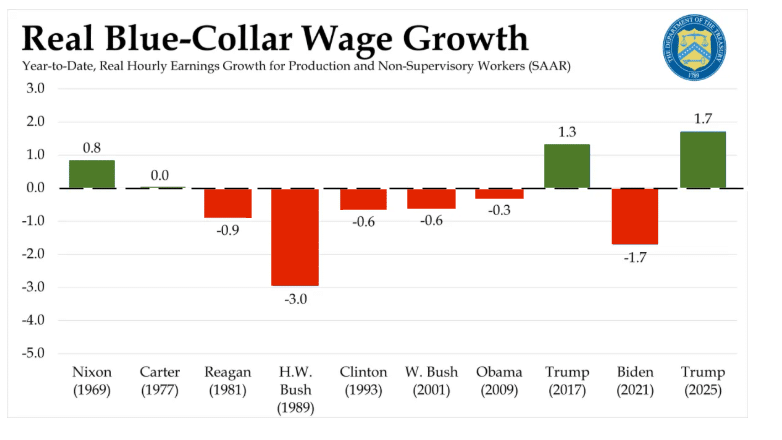According to recent data from the U.S. Department of the Treasury, in the first five months of President Donald Trump’s second term, blue-collar workers have experienced the strongest early-term wage gains for working-class Americans under any U.S. president in nearly 60 years. The 1.7% real (i.e., inflation-adjusted) wage increase sharply contrasts with negative growth under most Presidents.
Since President Richard Nixon took office in 1969, no other president has matched this level of early-term wage growth for non-supervisory and production workers. Nixon’s comparable figure stood at just 0.8% during his initial months in office. Trump’s latest achievement builds upon his previous track record; in his first term, blue-collar wages grew by 1.3% in the same period, already a strong showing, but now surpassed.
One key driver behind this improvement is the relatively low inflation rate, which has significantly increased the real purchasing power of hourly workers. As consumer prices stabilize, workers’ paychecks are going further, directly raising living standards for millions of American families. This economic tailwind has created breathing room in household budgets, particularly for workers in construction, manufacturing, and the transportation sector.
In addition to macroeconomic factors, policy decisions appear to be playing a pivotal role. Economic strategists credit the Trump administration’s renewed focus on manufacturing and domestic industry as a major catalyst.
“We’ve seen real wages for hourly workers, non-supervisory workers, rise almost 2% in the first five months,” Treasury Secretary Scott Bessent said. “No president has done that before.”
- Historically, wage growth for nonsupervisory workers typically rises 2% to 3% annually.
- A 1.7% increase in five months implies a potential annualized rate of 4.1%, which would be a very strong increase.
- If this is on top of 2.4% annual inflation, nominal wage growth would be 6.5%.
Trump’s policies have emphasized reshoring industrial production and limiting illegal immigration, both of which impact labor supply and wage dynamics. By restricting the number of undocumented workers in the job market, wages have been pushed upward for legal residents, especially in sectors where illegal labor has historically depressed earnings.
The Trump administration’s tax and regulatory policies have aimed to reduce barriers for businesses to invest in local labor. Targeted tax incentives and a continued push for tariffs on imported goods have encouraged companies to keep or bring back manufacturing operations to the U.S., creating a more competitive environment for skilled and semi-skilled American workers.
Whether this upward trend continues remains to be seen. Some might argue that early wage growth could be temporary or influenced by short-term factors. But these numbers could indicate something bigger is happening for workers who have often felt overlooked in the modern economy.
You might also like:


Leave a Reply